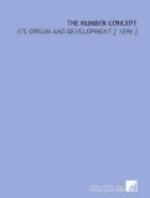1,
curiri, 2,
prica, many; and the Botocudos[23]
mokenam, 1,
uruhu, many. The Fuegans,[24]
supposed to have been able at one time to count to
10, have but three numerals,—
kaoueli,
1,
compaipi, 2,
maten, 3. The Campas
of Peru[25] possess only three separate words for
the expression of number,—
patrio,
1,
pitteni, 2,
mahuani, 3. Above
3 they proceed by combinations, as 1 and 3 for 4,
1 and 1 and 3 for 5. Counting above 10 is, however,
entirely inconceivable to them, and any number beyond
that limit they indicate by
tohaine, many.
The Conibos,[26] of the same region, had, before their
contact with the Spanish, only
atchoupre, 1,
and
rrabui, 2; though they made some slight
progress above 2 by means of reduplication. The
Orejones, one of the low, degraded tribes of the Upper
Amazon,[27] have no names for number except
nayhay,
1,
nenacome, 2,
feninichacome, 3,
ononoeomere,
4. In the extensive vocabularies given by Von
Martins,[28] many similar examples are found.
For the Bororos he gives only
couai, 1,
maeouai,
2,
ouai, 3. The last word, with the proper
finger pantomime, serves also for any higher number
which falls within the grasp of their comprehension.
The Guachi manage to reach 5, but their numeration
is of the rudest kind, as the following scale shows:
tamak, 1,
eu-echo, 2,
eu-echo-kailau,
3,
eu-echo-way, 4,
localau, 5. The
Carajas counted by a scale equally rude, and their
conception of number seemed equally vague, until contact
with the neighbouring tribes furnished them with the
means of going beyond their original limit. Their
scale shows clearly the uncertain, feeble number sense
which is so marked in the interior of South America.
It contains
wadewo, 1,
wadebothoa, 2,
wadeboaheodo, 3,
wadebojeodo, 4,
wadewajouclay,
5,
wadewasori, 6, or many.
Turning to the languages of the extinct, or fast vanishing,
tribes of Australia, we find a still more noteworthy
absence of numeral expressions. In the Gudang
dialect[29] but two numerals are found—pirman,
1, and ilabiu, 2; in the Weedookarry, ekkamurda,
1, and kootera, 2; and in the Queanbeyan, midjemban,
1, and bollan, 2. In a score or more of
instances the numerals stop at 3. The natives
of Keppel Bay count webben, 1, booli,
2, koorel, 3; of the Boyne River, karroon,
1, boodla, 2, numma, 3; of the Flinders
River, kooroin, 1, kurto, 2, kurto
kooroin, 3; at the mouth of the Norman River, lum,
1, buggar, 2, orinch, 3; the Eaw tribe,
koothea, 1, woother, 2, marronoo,
3; the Moree, mal, 1, boolar, 2, kooliba,
3; the Port Essington,[30] erad, 1, nargarick,
2, nargarickelerad, 3; the Darnly Islanders,[31]




